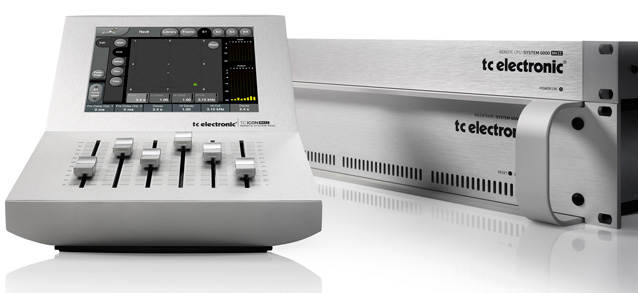TC Electronic has been at the forefront of reverb research and development for decades. With the arrival of Reverb 8, multichannel reverb reaches the next level, bringing world-class room simulation to new 3D sound formats.

Reverb 8
This is a new reverb algorithm for TC Electronic’s highly acclaimed System 6000 audio processing platform. A single System 6000 MKII frame is capable of running two Reverb 8 instances, delivering 16 output channels of ultra-realistic space. For an even higher channel count, multiple System 6000 MKII frames can be linked in a network, offering reverb for virtually any channel-count.
Reverb 8 may be fed with any input signal – mono, stereo, 5.1, 7.1, etc. – and deliver to an infinite number of output channels, perfectly suited for e.g. Dolby Atmos (up to 62.2 surround), Barco Auro (11.1 surround) or NHK’s multichannel broadcast format Super Hi-Vision (22.2 surround). In short, Reverb 8 goes from mono to infinity, or anywhere in between.
“For more than two decades of developing and refining some of the world’s finest room simulators, we have had the infinite “Lego brick” reverb as a goal. One missing link was the ability to add credible envelopment without artifacts even when a source already contained plenty of spatial information, for instance natural reverb from a microphone pick-up,” says Thomas Lund, CTO for Broadcast & Production at TC Electronic. “Reverb 8 has that essential quality without reverting to modulation. At the same time, high density distribution is becoming available. We’re confident artists, producers and audiences everywhere will reckon the super-natural 3D sound improvement Reverb 8 has to offer.”
Making The Most of More Channels
Extra discrete channels also means a possibility of conveying spaces more realistically than ever before, but only if the new channels are not wasted through simple matrix processing or phantom imaging. Making the most of 5.1 was also an objective when TC developed the industry’s reference upconverters, UnWrap and UpCon; but while they deliver great envelopment without adding any reverb, Reverb 8 offers whole new colors to the mixing-palette: The ability to add wild and imaginative spaces to even a mono source; where verb on verb is no longer an obstacle.
Furthermore, when multiple microphones are used to capture the sound of a hall for reproduction via loudspeakers, there has always been a compromise between imaging and envelopment. Still, skilled recording engineers have learned to strike a reasonable balance, even for 5.1. Adding extra microphones, however, to support yet more speaker channels, yields a diminished return because of the lack of relation between pick-up, direction, directivity and delivery of sound. The missing relationship between mics and speakers fundamentally works against such practice. Furthermore, with each microphone, correlation goes up, especially at low frequency where it’s needed the most. Therefore, multi-microphone capture is also to a large extent a waste of extra discrete channels.
Easy to Fly, Downmix Compatible
Reverb 8 takes hundreds of parameters into account in the rendering, so it was also paramount to develop a comprehensive user interface where spaciousness could be manipulated quicker, better and over a wider range than before. The new Grid display provides exactly that. Even if the Decay time is changed from 2 to 10 secs for all channels at an instant, Reverb 8 cleverly protects the balances of a mix so there is no need to counter-adjust a multitude of other parameters.
Another issue with traditional reverb, as well as with microphone arrays, is how the dry/wet balance often changes across format conversion. For most reverbs, even switching from stereo to mono offsets the mix balance. Imagine the same phenomena with a 32 channel system. Therefore, care has been taken to make Reverb 8 mix-down gracefully to 22, 11, 7, 5 or two channels. In fact, with Reverb 8 you may go from 32 channel rendering to mono without introducing phasing artifacts or altering the balance of a mix.
Included with Film 6000
Recently, TC Electronic introduced four application-specific version of System 6000: Music 6000, Film 6000, Broadcast 6000 and Mastering 6000. Since Reverb 8 is the perfect reverb tool for film production in particular, it is included as part of Film 6000, but it can also be purchased as a separate license for any System 6000 MKII at www.tc-now.com.
Reverb 8 is compatible with the System 6000 MKII mainframe only.
